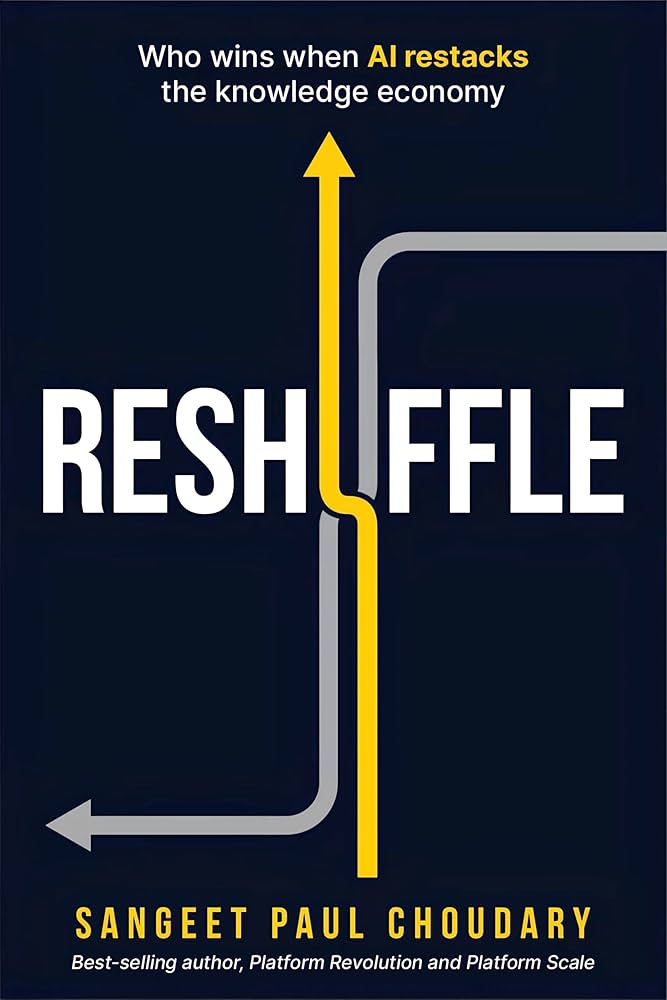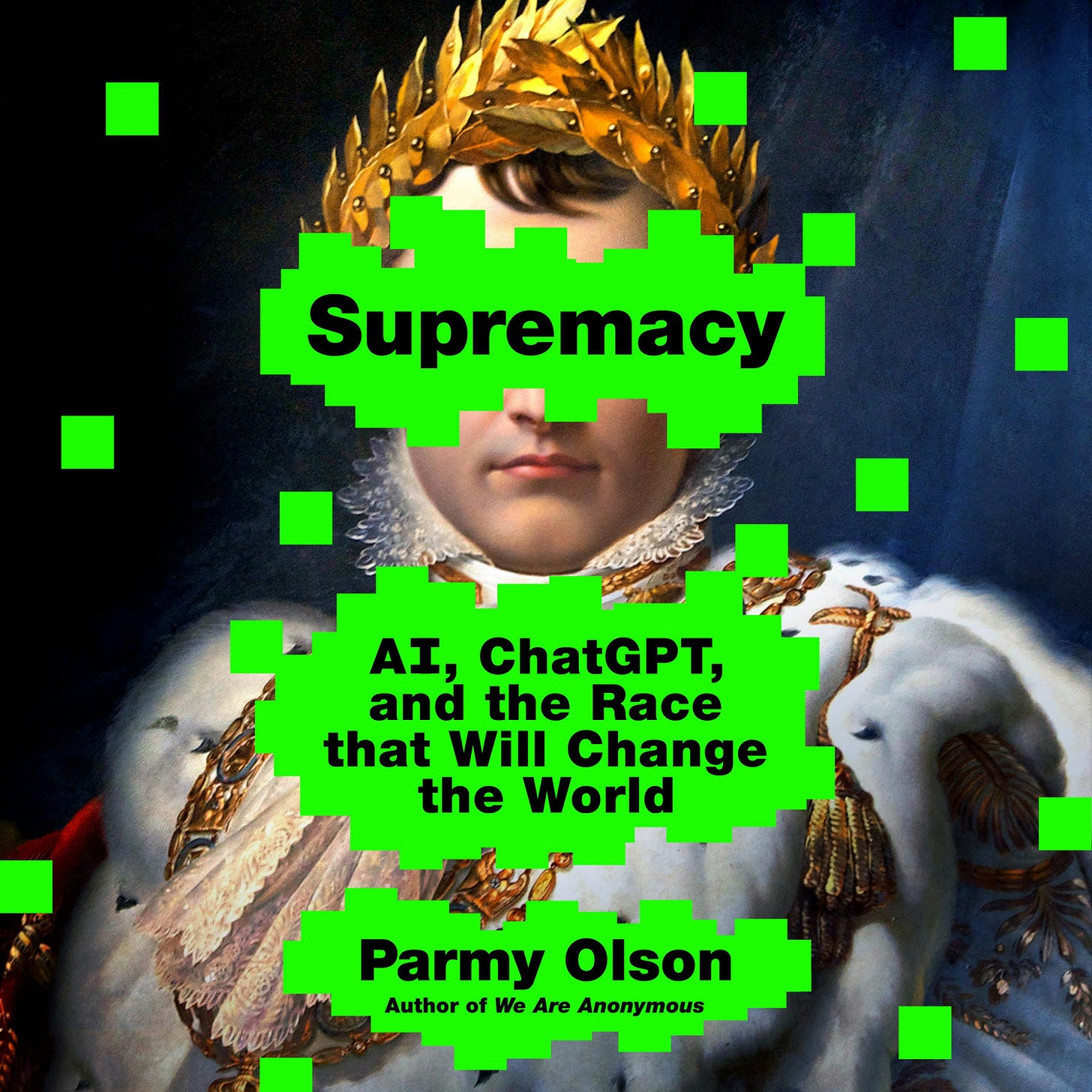Why AI experts get their predictions on jobs so wrong
The task-based fallacy that fools today’s top AI experts - also which AI books to read? 📚
This article is about one of the most accomplished AI authors I know on Substack. Promoting global voices and emerging writers is a privilege. 🙏
Sangeet Choudary is the best-selling co-author of Platform Revolution and the author of the new book Reshuffle. He has advised CEOs at more than 40 Fortune 500 companies as well as pre-IPO tech firms. It’s certainly a great time for awesome AI books.
According to
:Newsletter: Platforms, AI, and the Economics of BigTech
If you enjoy this piece, please subscribe to his newsletter:
The Newsletter is a great guide to strategy, policy and discovery in the age of platform systems, BigTech’s dominance, and AI.
🔮 Get to know the Author and about the New Book - 2 min :52
Trending Articles:
Figma - The untold story
Chegg, ChatGPT, and the changing nature of change
Tesla, SpaceX, and the economics of Stack Thinking
Don't sell shovels, sell treasure maps
"This feels like a generational book, not a mere bestseller." -
Prashant Kohl
What if we’ve misunderstood the real power of AI, not as a tool for doing tasks faster, but as the missing mechanism for making complex systems finally work together? In Reshuffle, Sangeet Paul Choudary reframes one of the most hyped technologies of our time not as a smarter brain, but as a better glue.
Reviews of Reshuffle: Who Wins When AI Restacks the Knowledge Economy by Sangeet Paul Choudary highlight its insightful and systems-level perspective on AI’s transformative impact on the knowledge economy. Below is a summary of key themes and sentiments from available reviews:
Praise for Systems Thinking and Clarity: Reviewers commend the book for moving beyond simplistic views of AI as a tool for task automation.
Practical and Strategic Insights: The book is described as a "lucid roadmap" for navigating technological disruption, particularly for executives and leaders.
Historical Analogies and Broader Perspective: The use of historical parallels, like the shipping container revolution or the barcode’s impact on retail, is frequently highlighted as a strength.
Reframing AI’s Role: The book is lauded for shifting the conversation from AI as a smarter tool to AI as a driver of new economic logic.
Sangeet is currently based in Dubai, UAE, read some of his recent posts on LinkedIn. Sangeet Paul Choudary is a business executive, advisor, and best-selling author. His ratings on Amazon and Goodreads are very high. I note his originality and layered insights.
Who else to read in AI book authors?
Amazon Best-Sellers in AI and Machine Learning currently feature books by
, , , and many others. Also by Parmy Olson:
Sangeet is currently a Senior Fellow at the University of California, Berkeley, and a Scholar at Dartmouth College. The book, Reshuffle: Who wins when AI restacks the knowledge economy.
Why AI experts get their predictions on jobs so wrong
By
, August, 2025.The task-based fallacy that fools today’s top AI experts
This article is based on the book Reshuffle and contains extracts from the book.
British computer scientist Geoffrey Hinton, often dubbed the “Godfather of AI” famously predicted in 2016 that AI would soon replace radiologists. Much of the job involves interpreting medical images, a task that lends itself well to machine learning. Algorithms, trained on vast image datasets, can detect patterns of disease with remarkable precision. Yet, nearly a decade down, radiology hasn’t disappeared; it has flourished. What’s striking is that at most tasks in radiology, AI already outperforms humans. So why are radiologists still in demand?
Hinton’s prediction about radiologists might have missed the mark, but it stands as a larger lesson: expert pronouncements on AI’s future often oversimplify the complex dynamics of work, reducing roles to collections of tasks that machines can supposedly supplant. And that trend hasn’t slowed. Dario Amodei, Sam Altman, Eric Schmidt, and others have all made similar pronouncements about other jobs.
Some of this can be attributed to hype, but even the most well-meaning of pronouncements - sometimes by researchers who have little to gain financially from such statements - also fall into the same trap.
And that is the oversimplistic explanation that jobs are essentially just sets of tasks.
The task-based fallacy
We often think of jobs in terms of the tasks people perform, not least because the roles we’re familiar with - teacher, designer, plumber - are themselves descriptive of the tasks they are associated with.
Such a task-based view of work often leads us to ask which tasks will lose value once AI can perform them more efficiently and cost-effectively. In response, we try to shift toward other tasks that AI hasn’t yet mastered. However, this mindset puts us in a constant race against the machine, always chasing the next task that AI can’t take over.
Our jobs, however, don’t exist solely around the performance of certain tasks. Jobs, instead, are part of larger systems - workflows, organizations, industries - and are structured to resolve constraints in those systems. When that constraint collapses, the logic for the role no longer holds.
The typist’s dilemma
People often assume their jobs are safe because the tasks involved seem resistant to automation. But what if that’s not enough? If we look beyond individual tasks and consider the broader system that makes a role necessary, we find that a role can vanish, even while the tasks it once involved continue.
Consider what happened to typists in the late twentieth century. Before the advent of word processors, workflows were designed around typists. Entire teams coordinated with typing pools. Errors were expensive and required retyping entire documents. Formatting had to be done within the physical limitations of the typewriter. The typist’s role was structured around managing these constraints.
Then the word processor arrived.
At first glance, it seemed like a productivity tool that would speed up the work of typists. But word processors collapsed the costs that had once justified the typist role. The cost of fixing errors dropped to zero. Revisions could be made instantly, and formatting could be automated.
The task of typing didn’t disappear - humans were still required to perform it, in fact, more than ever before - but the job of the typist no longer made sense. The role existed not to perform the task but to manage the constraint created by the high cost of managing errors and revisions. Once word processors eliminated those costs, the job bundle lost its economic rationale. Typing became a distributed task, absorbed into the broader workflows of knowledge work. Typists weren’t outperformed by better typists equipped with new tools; they were displaced by a system in which typing no longer required a dedicated role.
The task-centric view sees AI as a tool that improves how individual tasks are performed. Work remains structurally unchanged. AI is simply layered on top to improve speed or lower costs. In this framing, the main risk is that a smarter tool might replace the person doing the task. The proposed solution is straightforward: people should learn to use the tool to stay relevant and keep their jobs.
The system-centric view, on the other hand, looks at how AI reshapes the organization of work itself. It focuses on how tasks fit into broader workflows and how their value is determined by the logic of the overall system. In this view, even if tasks persist, the rationale for grouping them into a particular job, or even performing them within the company, may no longer hold once AI changes the system’s structure.
A crash-course on AI by Steph Curry
To truly understand how AI affects jobs, we must look beyond individual tasks to comprehend AI’s impact on our workflows and organizations. And to understand how AI changes organizations, we need to understand how AI changes the very basis of competition for companies - and, with that, the reason those organizations exist in the first place.
To do that, we need to shift our lens from focusing on whether AI can perform a task to understanding how AI changes the entire system that gives that task its purpose and value.
The task-centric view treats jobs as stable bundles of tasks, which evolve as the constituent tasks are gradually replaced or enhanced over time. Automation and augmentation are seen as the only two effects.
In contrast, the system-centric view doesn’t see jobs as fixed roles. It sees them as temporary groupings of tasks that make sense in a specific system. When AI changes the system, new roles emerge in response to a new system. The impact of AI on jobs is, then, determined not just by AI’s impact on a job’s constituent tasks, but on AI’s impact on how those tasks are organized to help firms compete more effectively.
Top 5 pieces from my newsletter
⚗️ The many fallacies of ‘AI won’t take your job but someone using AI will’: The top article on Sangeet’s substack with more than 100,000 reads and nearly a thousand likes. Highly recommend!
😂 How to intellectually debate AI while completely missing the point: A central fallacy that Sangeet tackles in his book Reshuffle to dismiss both AI boomers and doomers.
💡 Humans as luxury goods in the age of AI: A powerfully argued piece on the human advantage in the age of AI.
😲 You think you are AI-first, but you probably aren’t: This piece completely flips how we think about building an AI-first startup.
🦄 When answers get cheap, good questions are the new scarcity: Where does new advantage lie in an age of abundant LLM-generated answers.
The article continues below and uncovers how AI reshuffles everything!
Keep reading with a 7-day free trial
Subscribe to AI Supremacy to keep reading this post and get 7 days of free access to the full post archives.










